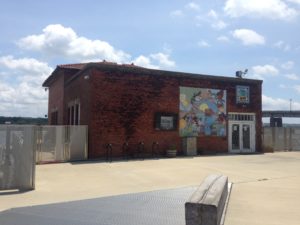 In November of 2020, the DC Preservation League submitted a landmark nomination for the Capitol Power Plant Pump House, located at First Street and Potomac Avenue SE. This distinctive structure played an essential role in supporting the modernization of the U.S. Capitol building, enabling the Capitol Power Plant to function for over forty years (during the plant’s establishment and considerable expansion).
In November of 2020, the DC Preservation League submitted a landmark nomination for the Capitol Power Plant Pump House, located at First Street and Potomac Avenue SE. This distinctive structure played an essential role in supporting the modernization of the U.S. Capitol building, enabling the Capitol Power Plant to function for over forty years (during the plant’s establishment and considerable expansion).
Sitting on a pier in the Anacostia River, the structure is now owned by the DC Government and leased to a nonprofit known as the Earthworks Conservation Corps. The pump house was built between 1908 and 1910; its period of significance is from 1910 to 1961.
The Capitol Power Plant Pump House was constructed during the same period in which engineering firm Westinghouse, Church, Kerr, Inc. built the Capitol Power Plant, its equipment, and related buildings. This modern idea of a separate plant to provide heat, forced ventilation and electricity for the Capitol and new Library building was necessitated by the planned addition of an office building for the House of Representatives. House offices had suffered from considerable crowding, with the steady increase in members—from 303 in 1859 to 447 in 1901—since the Capitol expansion.
Connected to the northeastern bank of the Anacostia River by a short bridge, the pump house provided water to the power plant through a mile-long network of mains running beneath city streets. The power plant boilers originally used this water to produce steam to generate electricity and heat for the Capitol complex.
The Capitol Power Plant, and by extension the pump house, was praised early in its existence. In his 1914 Annual Report, the Architect of Capitol declared:
Referring to the Capitol power plant, I will state that the construction, operation, and final results have fully justified Congress in its efforts to combine for the Capitol, the two office buildings and the Library of Congress a central source of supply for all heat, light, and power.
The power plant constituted an important achievement in the development of central heating and power (and later air conditioning) in the District, a relatively new technology which was in time applied to many other campuses within the city. In 1950-51, with Capitol demand for electricity rising, which also meant the increase in demand for professionals like a commercial electrician, the Superintendent arranged to procure power from the local utility, PEPCO, and so discontinued production at the Capitol Power Plant.

The pump house is a virtually unique example in Washington of a small water in-take facility and still shows its original use both inside and outside. For these reasons, the Capitol Power Plant Pump House qualifies for designation under DC Inventory Criterion B (History) and similar National Register Criterion A.


